We're pretty excited for an open student proposal event to be put on by the AIAS here at RISD; The Media Facade Festival:
Read MoreSacred Groves
A landscape always exists in an ephemeral state in comparison to most architecture. Much of its makeup often being organic, there is an expiration date unless certain remediations take place....
Read MoreLinks in the Landscape Realm
 {Project Image by Wen Ying Teh}
{Project Image by Wen Ying Teh}
I've read some recent great posts on the interwebs and originally intended to expand upon them in a few DUS posts, but time has been limited as of late. Below are a few quick summaries and links of recommended reading:
If Mammoth isn't in your RSS feed then quickly remedy that. Architect authors Rob Holmes and Stephen Becker have and continue to produce several expansive posts of the landscape infrastructure persuasion.
The conveyor belt, at 18 kilometers the third longest in the world (at least at the time of its design), was planned to create a more efficient means for Dead Sea Works company to convey over a million tons of potash each year from the extraction site (400 meters above sea level) to the Dead Sea Works’ main factory on the banks of the Dead Sea (400 meters below sea level). The plan for a conveyor belt was established, but due to it's intended path(which would span the entire South Judean Desert Nature Reserve) was opposed by Israel’s Nature Reserves Authority, unless, a Landscape Architect was employed to design the conveyor belt.
Israeli landscape architect Shlomo Aronson was selected by Dead Sea Works for the job. The main objective, minimum impact to the desert ecology. More....
The Gardens of the Delta National Park | Delta National Park
An aerial summary of some of the various gardens of the DNP, and as they may soon become a open to the public, a comparison on the transition of French gardens, hunting grounds began as royal enclaves, but ultimately became beloved public parks. More....
An Augmented Ecology of Wildlife and Industry | Wen Ying Teh | dpr-barcelona
Born from from three week trip following Darwin's southern voyage to the Galapagos Islands and South America, 2009 President's Medal Student award winner Weng Ying Teh mutually includes salt mining, flamingo habitats, and tourism into what Teh calls a "symbiotic designed ecology; a pink wonderland, built from colored bacteria and salt crystallization, dissolving and reshaping itself with seasonal and evaporative cycles. The building becomes an ecosystem in itself, completely embedded in the context that surrounds it." More....
The CLOUD

The CLOUD, as named by its designers is the result from an extensive collaboration of multi-disciplinary teams for a competition set up by London Mayor Boris Johnson committed to build a tourist attraction in the Olympic Park "with a legacy for the east end [of London]"
The team, comprised of an international team of artists, engineers, and architects included Arup engineers, architecture largely by Carlo Ratti, Walter Nicolino, Atmos, SENSEable City Lab, and landscape architecture by Agence Ter among many others, one being Dan Hill of City of Sound.
The Cloud, as it is known, and its spheres are intended to be made from from plastic known as Ethylene tetrafluoroethylene (ETFE), the material used to build the Beijing Aquatic Centre. The spheres act as an observation deck, a park, and LCD screens to allow for the digital display of information.
"We could provide a custom feed of… searches made by Londoners during the Olympics to give a real time 'barometer' of the city's interests and mood," said Google, one of the supporters of the project, which has also offered to provide the information feeds.
The team also envisage projecting weather information, spectator numbers, race results or even images of the Olympic Torch on to the building.
Ramps, stairs and lifts would carry people to the top of the structure to look out over the city.
Its a work of interactive architecture, more then a space or structural element, but a beacon of real-time digital communication. The CLOUD brings an illusionary story to its citizens and locale, allowing people to feel as architectural participants rather then simply observers.
While the mayor is still in the "process of the deciding," the design team plans on reaching out to millions of people for micro-donations to build the project. This is interesting, as I recently spoke to a landscape architect friend about applying micro-finance to building parks. The idea, if parks are for people, why wait for developers to supply the money, through small donations from thousands of potential visitors, we can build what we want (at least, that's the idea).
The project brief:
The CLOUD proposes an entirely new form of observation deck,connecting visitors to both the whole of London and the whole of the world, immersing them in the euphoric gusts of weather and digital data. Each individual footstep on the ascent to the CLOUD participates in a vast collective energy-harvesting effort. Everyone from around the world can contribute to the Cloud - whether by visiting or by sponsoring an LED, helping to keep the Olympic lamp aflame. [From the CLOUD website]
I'm looking forward to seeing the progression of the project and hope it comes to fruition. It could make for an excellent precedent in cross-disciplinary collaboration and citizen development.
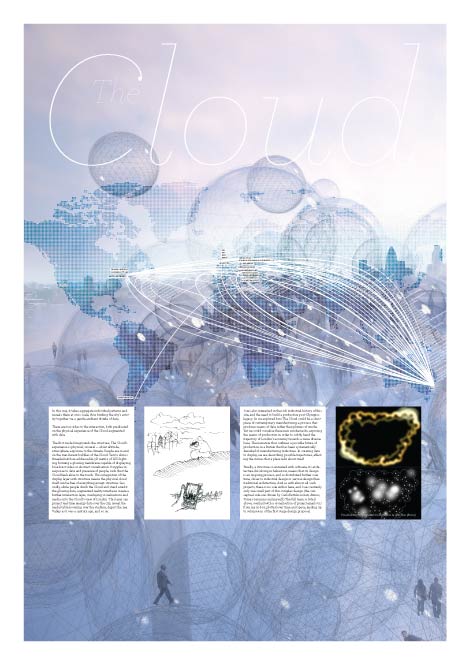
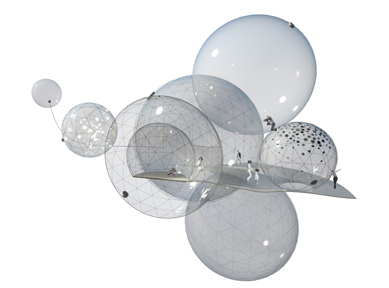
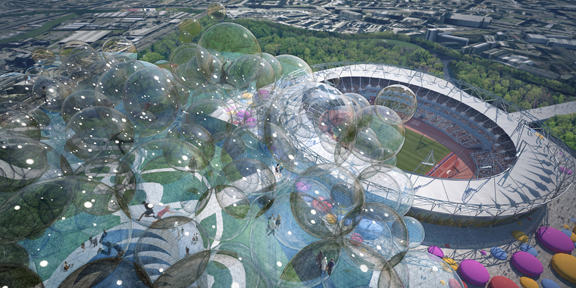
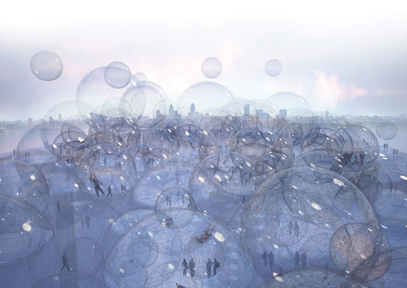
+ Images via The CLOUD
Are We a Cancer on the Planet?
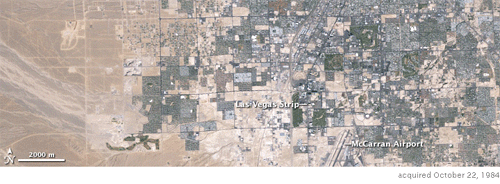 {25 years in six seconds via Archidose}
{25 years in six seconds via Archidose}
It's images like these, NASA satellite photos of 25 years of the growth of Las Vegas, that depict our existence as infectious growth on the land. Maybe I'm just feeling particularly cynical today, but is there any other way to describe it.
Our incessant need for "things" (full disclosure, I'm re-reading Thoreau's Walden) drives our ambitions at a unfounded pace. It began in the U.S. with Manifest Destiny, our seemingly inherent nomadic tendencies to wander, to find new lands, which is fine until our technology became so that we left scars on the land wherever we traveled.
It is a truly scary self-reflection to actually sit down and ask, "Why the fuck do we do it all?" Why do we build tall buildings? Why do we build giant corporations, hoard giant monies, build giant houses? It's scary, because if you answer it correctly, much of what we've frantically pursued in our lives (including my own), just doesn't mean much.
Sure, we're a product of everyone before us, it would be naive of me to think, at this point, at least in most areas in America, there is opportunity to live as comfortably as Thoreau does at Walden Pond, the space and resources just aren't there. But this paradigm shift we're reaching in sustainable living, and this global financial meltdown makes me think it's possible, and makes sense to return to a similar type of living. Not living beyond what we actually need as humans, food and shelter. Everything else might be considered frivolous pursuits.
 {Simon Dale's hand-built home for $5,000}
{Simon Dale's hand-built home for $5,000}
A young couple in Whales is doing just that. Managing on an annual income of just $10,000 went ahead and built their own cheap home anyway, sustainably, mostly out of materials from “a rubbish pile somewhere.”
They had wanted to spend as much time as possible at home while their two children were young. Their nearby woodlands ecological management work would have been impractical if they were paying a mortgage. So with the help of some friends and people simply passing by completed their very low impact homemade house. A hand built unique setting for a charmed life for their two young toddlers. Completed in just four months. Total expenditure? $5,000. Tools? A chisel, a chainsaw and a hammer. Building expertise? Home owner Simon Dale says:
“My experience is only having a go at one similar house 2yrs before and a bit of mucking around in-between. This kind of building is accessible to anyone. My main relevant skills were being able bodied, having self belief and perseverance and a mate or two to give a lift now and again.”
Sustainable design and construction:
- Dug into hillside for low visual impact and shelter
- Stone and mud from diggings used for retaining walls, foundations etc.
- Frame constructed of fallen trees from surrounding woodland
- Reciprocal roof rafters are structurally very easy to do
- Straw bales in floor, walls and roof for super-insulation and easy building
- Plastic sheet and mud/turf roof for low impact and ease
- Lime plaster on walls is breathable and low energy to manufacture compared to cement
- Reclaimed (scrap) wood for floors and fittings
- Other items were reclaimed from “a rubbish pile somewhere”: windows, wiring, plumbing
The Dale's are now working on a precedent setting settlement of nine low-impact smallholdings where families can live and work on the land for a simple livelihood.
So its clearly possible, and I'd like to think we have the capability to live without greed, but I think it would take a massive event to globally change our living mentalities at this point.

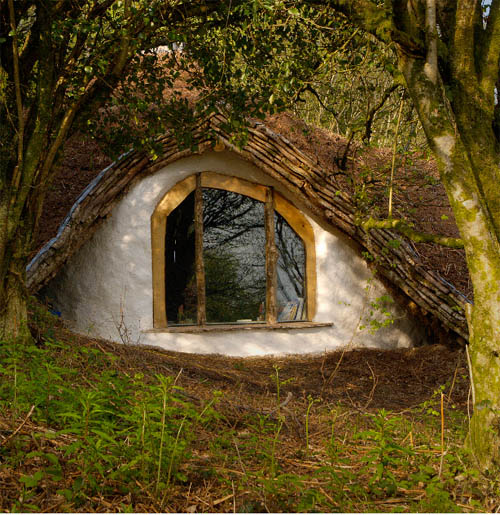
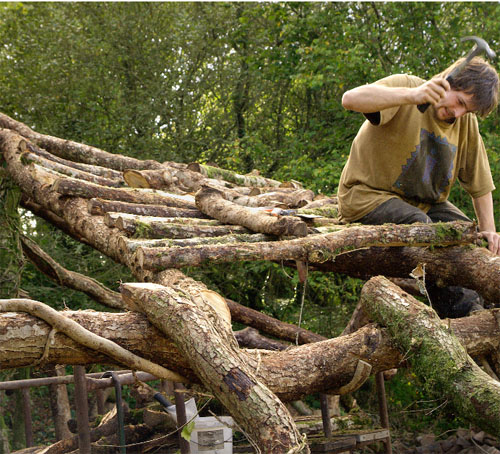 {Simon Dale's hand-built home for $5,000}
{Simon Dale's hand-built home for $5,000}
